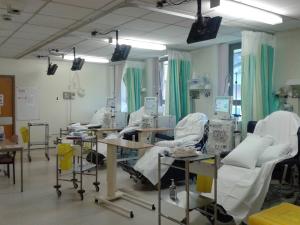Key learning point
Light fitting change resulted in improved the energy efficiency leading to carbon reduction whilst improving illumination and saving finances.
Setting/Patient Group: Renal Unit (offices and wards)
Issue to be addressed:
Energy is responsible for approximate 10% of the carbon footprint of the NHS.
The unit invested in a greener energy initiative using a British Journal of Renal Medicine (BJRM) Innovation in Renal Medicine Award 2011 prize (£5,000).
Fluorescent light fittings in the renal unit were of a 'T8' type, whose energy consumption was double that of newer 'T5' light fittings and not effective enough produce sufficient illumination for technical staff.
Intervention:
- Site survey of the renal unit and staff consultation to identify areas of intervention
- Switch to install 'T5' light fittings (changing 85 fittings across renal offices and wards)

Outcome:
Clinical
- Improved illumination for technical staff
Social
- Happier staff due to increased levels of lighting.
- An improved working environment
Environmental
- Estimated annual carbon savings of 2.3 tonnes CO2e/yr, projected to 11.5 tonnes of CO2e over 5 years.
- Improvement in measured lighting levels and reduced maintenance costs as the new light fittings have a longer life span
- Contributes to the achievement of the Trust's sustainable development goals
Economic
- Estimated annual savings £612/yr.
Please log in or sign up to comment.